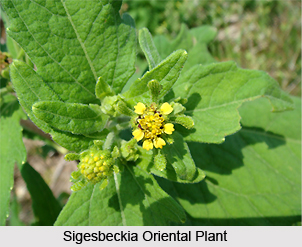 Sigesbeckia Oriental has curative properties and thus, this tree is an Indian Medicinal Plant. The herb is of Pantropical and subtropical type and is distributed allover the country. It is common in disturbed moist forests and open habitats. Sigesbeckia Oriental reaches up to height of 2500 m elevation in the Himalayas. This Indian medicinal plant is known by different common names. In Gujarati, it is called pilibadkadi, in Kannada; this plant is known as antu-huvinagida, in Tamil, Sigesbeckia Oriental is kadambu, katampam where as in Telegu, it is kadambu, or katampam.
Sigesbeckia Oriental has curative properties and thus, this tree is an Indian Medicinal Plant. The herb is of Pantropical and subtropical type and is distributed allover the country. It is common in disturbed moist forests and open habitats. Sigesbeckia Oriental reaches up to height of 2500 m elevation in the Himalayas. This Indian medicinal plant is known by different common names. In Gujarati, it is called pilibadkadi, in Kannada; this plant is known as antu-huvinagida, in Tamil, Sigesbeckia Oriental is kadambu, katampam where as in Telegu, it is kadambu, or katampam.
The Indian medicinal plant Sigesbeckia Oriental is an erect, pubescent and aromatic annual herb. The height of the plant goes up to 1.2 meter. This plant has stem and branches with purple tinge. The stems are terete as well as pubescent. In Sigesbeckia Oriental leaves grow in the opposite direction. Each leaf is 5 to 12 centimeter long and 3.2-7 centimeter wide. The leaves are triangular-ovate in shape and apex is acute or acuminate, margins deeply and irregularly toothed. Uppermost leaves in this Sigesbeckia Oriental are much smaller and nearly entire. They are finely pubescent on both surfaces with base cuneate. The leaves are leaf-stalk winged and are 3-nerved. Each flower of this Indian medicinal plant is yellow or rarely white in colour. Those of the ray red beneath are available in the arrangement of few to many in small paniculate heads in sticky, leafy panicles. Achenes are black, obovoid, glandular and enclosed in boat-shaped bracts.
Sigesbeckia Oriental has innumerable medicinal properties. This herb finds is application in almost all part of the country. The plant is highly valued in traditional Indian medicine as a depurative and as an external application in the treatment of gangrenous ulcers and sores. A paste of this Indian medicinal plant is used by the Uraon in southern Bihar to promote healing of boils and ulcers. The fresh juice is applied as a dressing over wounds and it leaves a varnish-like coating as it dries. A tincture of the plant is used externally with glycerine to cure ringworm and other parasitic infections. It has been used to treat rheumatism and renal colic.
The tincture from this Indian medicinal plant is considered to be cardiotonic, diaphoretic, antiscorbutic and sialagogue, and is sometimes employed as an anthelmintic. An extract of the plant is credited with hypoglycaemic and antiviral properties. The leaf juice is reportedly important among the Rabari in the Barda Hills of Gujarat as it is used to treat diseases of the urinary tract.



















